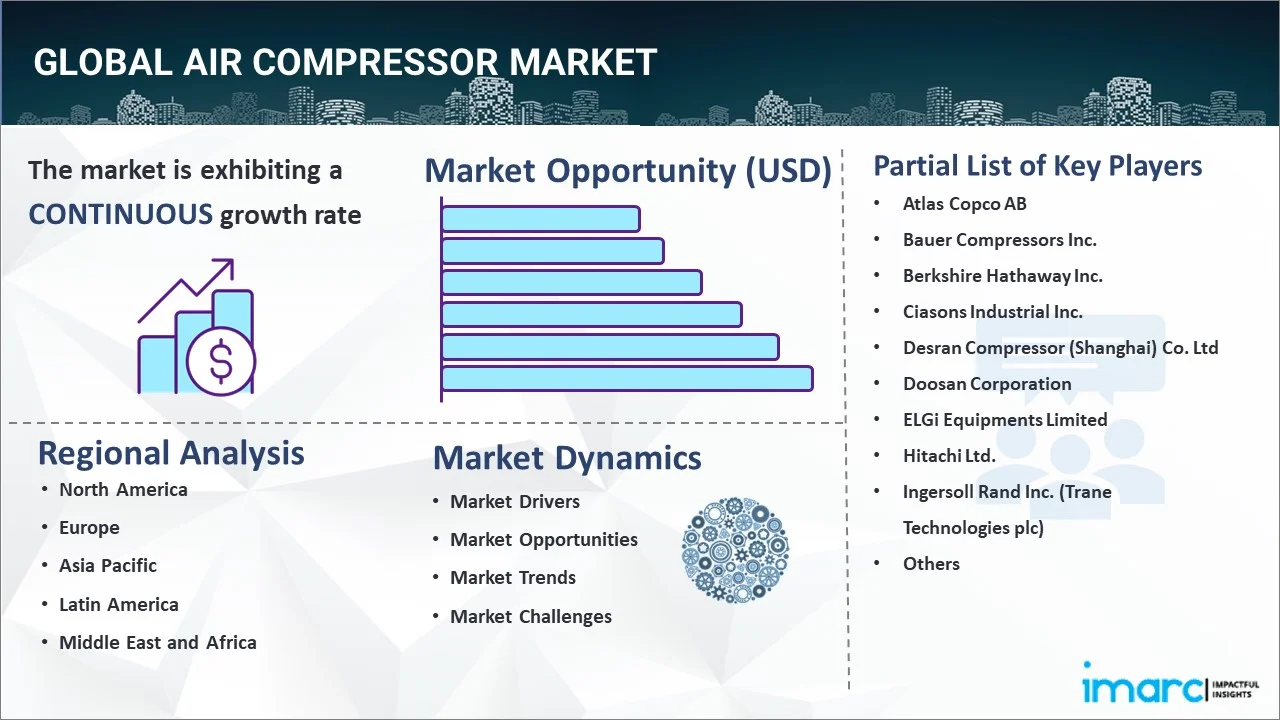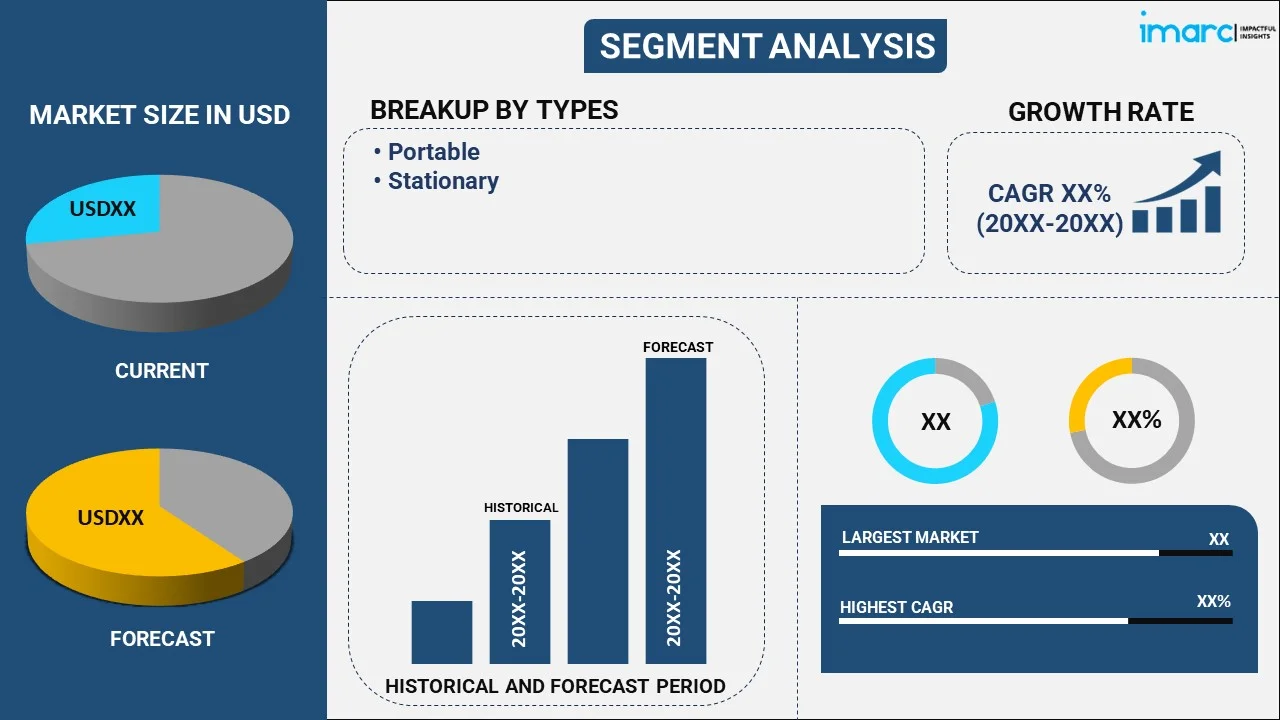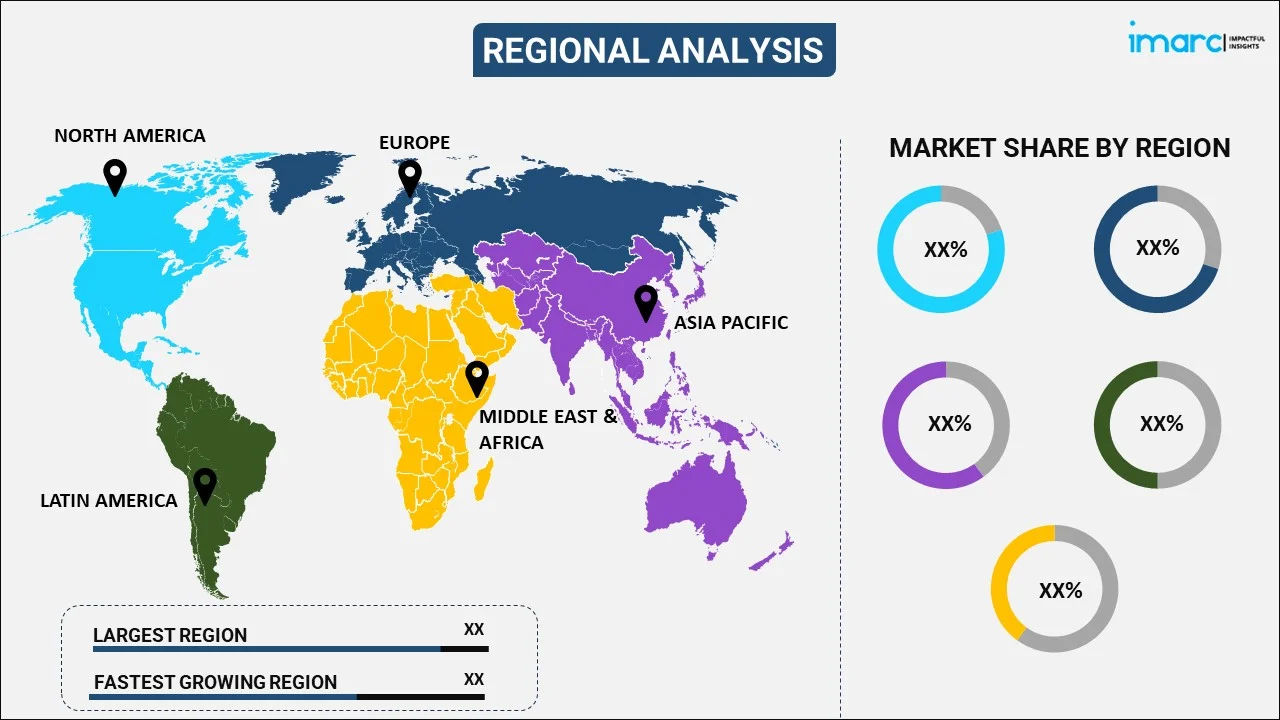
Air Compressor Market Report by Type (Portable, Stationary), Technology (Reciprocating/Piston, Rotary/Screw, Centrifugal), Lubrication Method (Oil-filled, Oil-free), Power Rating (0-100 kW, 101-300 kW, 301-500 kW, 501 kW and Above), End User (Manufacturing, Semiconductors and Electronics, Food and Beverages, Healthcare/Medical, Home Appliances, Energy, Oil and Gas, and Others), and Region 2025-2033
Air Compressor Market, 2024 Size and Share:
The global air compressor market size reached USD 19.1 Billion in 2024. Looking forward, IMARC Group expects the market to reach USD 25.6 Billion by 2033, exhibiting a growth rate (CAGR) of 3.12% during 2025-2033. The increasing industrial applications, emphasis on energy efficiency, growing adoption of automation and pneumatic systems, and significant advancements in IoT and smart technologies are some of the major factors propelling the market.
|
Report Attribute
|
Key Statistics
|
|---|---|
|
Base Year
|
2024
|
|
Forecast Years
|
2025-2033
|
|
Historical Years
|
2019-2024
|
|
Market Size in 2024
|
USD 19.1 Billion |
|
Market Forecast in 2033
|
USD 25.6 Billion |
| Market Growth Rate (2025-2033) | 3.12% |
An air compressor refers to a type of mechanical device that converts power from an electric motor or gasoline engine into potential energy stored in compressed air. It is designed to increase the air pressure, leading to the compression of gases. These compressors are utilized in various industries for tasks such as powering pneumatic tools, filling gas cylinders, and providing a continuous supply of compressed air for machinery. They play a vital role in facilitating processes that require high-pressure air, making them essential for diverse applications in manufacturing, construction, automotive, and other sectors.

The increasing demand for compressed air in various industrial applications, such as manufacturing, oil and gas, automotive, and construction, represents one of the key factors fueling the market growth. Besides this, the rising need for efficient power tools and equipment that rely on compressed air for operation is propelling the market growth. Moreover, the rising focus on energy efficiency and sustainable practices is urging manufacturers to develop advanced air compressors that consume less power and reduce carbon emissions, thereby strengthening the market growth. In addition to this, the expanding adoption of automation across various industries is driving the employment of pneumatic systems, thereby boosting the demand for air compressors. Furthermore, rapid industrialization in emerging economies and the expansion of the manufacturing sector are creating lucrative opportunities for air compressor providers.
Air Compressor Market Trends/Drivers:
Increasing industrial applications
One of the key factors driving the air compressor market growth is the rising demand for compressed air in various industrial applications. Industries such as manufacturing, oil and gas, automotive, construction, and mining heavily rely on compressed air for a wide range of processes, which, in turn, is creating a positive outlook for market expansion. In addition to this, the surging need for compressed air to power pneumatic tools and equipment, control valves, and operate conveyor systems is presenting remunerative growth opportunities for the market. As industrial activities continue to expand and diversify globally, the demand for air compressors is steadily increasing.
Rising emphasis on energy efficiency
With growing concerns about environmental sustainability and energy conservation, there is a strong emphasis on developing energy-efficient solutions in the industrial sector. Air compressors, being power-hungry devices, have drawn attention to their energy consumption. In response, manufacturers are focusing on the design and development of energy-efficient air compressors that minimize power usage and reduce carbon emissions, thereby contributing to the market's growth. Furthermore, these energy-efficient models not only help industries meet their sustainability goals but also result in cost savings for end-users, making them an attractive choice.
Expanding automation and rising demand for pneumatic systems
The rising adoption of automation in various industries is another crucial factor driving the air compressor market. Automated systems rely on pneumatic components and controls that require compressed air to function effectively. As a result, with expanding automation, there is a surging demand for air compressors as a reliable source of compressed air, which, in turn, is acting as another significant growth-inducing factor. Concurrent with this, the shifting consumer preference for pneumatic systems in industries due to their safety, versatility, and ease of maintenance is bolstering the demand for air compressors.
Air Compressor Industry Segmentation:
IMARC Group provides an analysis of the key trends in each segment of the global air compressor market report, along with forecasts at the global, regional and country levels from 2025-2033. Our report has categorized the market based on type, technology, lubrication method, power rating and end user.
Breakup by Type:

- Portable
- Stationary
Stationary dominates the market
The report has provided a detailed breakup and analysis of the market based on the type. This includes portable and stationary. According to the report, stationary represented the largest segment.
The demand for stationary air compressors is being propelled by their suitability for long-term and continuous applications in various industries. Unlike portable compressors, stationary models are installed in fixed locations and provide a constant and reliable supply of compressed air, which propels their adoption. Moreover, they are highly preferred for tasks that require a consistent source of compressed air, such as powering industrial machinery, pneumatic systems, and assembly lines. In addition to this, stationary compressors often have higher capacity and efficiency, making them well-suited for heavy-duty applications and contributing to their increasing demand in industrial settings.
Breakup by Technology:
- Reciprocating/Piston
- Rotary/Screw
- Centrifugal
Rotary/screw holds the largest share in the market
A detailed breakup and analysis of the market based on technology has also been provided in the report. This includes reciprocating/piston, rotary/screw, and centrifugal. According to the report, rotary/screw accounted for the largest market share.
The surging demand for rotary/screw air compressors can be attributed to their high efficiency and reliability in meeting industrial compressed air requirements. Additionally, these compressors utilize a continuous rotary motion, resulting in smooth and pulsation-free air delivery, making them ideal for applications demanding constant air pressure. Moreover, their ability to operate continuously without the need for frequent starts and stops improves overall energy efficiency and reduces maintenance costs, thus aiding in market expansion. Besides this, rotary/screw air compressors are favored in industries where a steady supply of compressed air is essential, such as manufacturing, food processing, pharmaceuticals, and automotive, further driving their demand in the market.
Breakup by Lubrication Method:
- Oil-filled
- Oil-free
Oil-filled dominates the market
The report has provided a detailed breakup and analysis of the market based on the lubrication method. This includes oil-filled and oil-free. According to the report, oil-filled represented the largest segment.
The expanding demand for oil-filled air compressors driven by their superior performance in heavy-duty and high-pressure applications is strengthening the market growth. These compressors use oil as a lubricant, which not only reduces friction but also helps dissipate heat effectively, ensuring smooth and efficient operation even under demanding conditions. Moreover, the presence of oil provides better sealing between components, leading to improved efficiency and a longer lifespan. Consequently, industries requiring consistent and high-pressure compressed air, such as construction, mining, and manufacturing, are increasingly opting for oil-filled air compressors for their reliability and ability to withstand rigorous working environments.
Breakup by Power Rating:
- 0-100 kW
- 101-300 kW
- 301-500 kW
- 501 kW and Above
101-300 kW holds the largest share in the market
A detailed breakup and analysis of the market based on the power rating has also been provided in the report. This includes 0-100 kW, 101-300 kW, 301-500 kW, and 501 kW and above. According to the report, 101-300 kW accounted for the largest market share.
The demand for 101-300 kW air compressors is being propelled by their ability to cater to medium to large-scale industrial operations with higher compressed air requirements. These powerful compressors offer greater capacity and efficiency, making them suitable for heavy-duty applications in industries such as mining, petrochemicals, and steel manufacturing. As these sectors continue to expand, the need for reliable and high-performance air compressors in the specified power range has increased, contributing to the market's growth. In addition to this, significant advancements in technology have led to more energy-efficient models, further boosting the demand for 101-300 kW air compressors among businesses seeking cost-effective and sustainable solutions.
Breakup by End User:
- Manufacturing
- Semiconductors and Electronics
- Food and Beverages
- Healthcare/Medical
- Home Appliances
- Energy
- Oil and Gas
- Others
The report has provided a detailed breakup and analysis of the market based on the end user. This includes manufacturing, semiconductors and electronics, food and beverages, healthcare/medical, home appliances, energy, oil and gas, and others.
Air compressors' versatility and critical role in diverse applications primarily drive their demand across manufacturing, semiconductors and electronics, food and beverages, healthcare/medical, home appliances, energy, oil, and gas industries. In manufacturing, air compressors enable efficient production processes by powering pneumatic tools and equipment. They supply clean air and are used in precision applications in the semiconductors and electronics industry. They assist in packaging and processing in the food and beverages industry. In healthcare/medical, air compressors support medical device operations. They are utilized in air conditioning and refrigeration units in home appliances. In the energy, oil, and gas sectors, air compressors facilitate various drilling, transportation, and processing tasks, marking them as essential equipment for these industries.
Breakup by Region:

- North America
- United States
- Canada
- Asia-Pacific
- China
- Japan
- India
- South Korea
- Australia
- Indonesia
- Others
- Europe
- Germany
- France
- United Kingdom
- Italy
- Spain
- Russia
- Others
- Latin America
- Brazil
- Mexico
- Others
- Middle East and Africa
Asia-Pacific exhibits a clear dominance, accounting for the largest air compressor market share
The report has also provided a comprehensive analysis of all the major regional markets, which include North America (the United States and Canada); Asia Pacific (China, Japan, India, South Korea, Australia, Indonesia, and others); Europe (Germany, France, the United Kingdom, Italy, Spain, Russia, and others); Latin America (Brazil, Mexico, and others); and the Middle East and Africa. According to the report, Asia-Pacific accounted for the largest market share.
The demand for air compressors in the Asia Pacific region is being propelled by rapid industrialization and infrastructural development. Moreover, as the region witnesses significant economic growth, various industries such as manufacturing, construction, automotive, and electronics are expanding their operations. This, in turn, leads to an increasing need for compressed air to power pneumatic machinery, tools, and equipment. Apart from this, the growing focus on energy efficiency and sustainability in emerging economies such as China and India is driving the adoption of advanced air compressors that offer higher efficiency and reduced carbon emissions, further fueling the demand in the Asia Pacific air compressor market.
Competitive Landscape:
The global air compressor market is distinguished by a highly competitive landscape with numerous key players vying for market share. Established companies continuously invest in research and development to introduce innovative and energy-efficient air compressor solutions, catering to various industries and customer needs. Besides the major players, there is also a presence of numerous regional and local manufacturers offering cost-effective air compressor solutions, particularly in emerging economies. These companies often focus on specific market segments or niche applications to gain a competitive edge. Besides this, technological advancements, such as the integration of IoT and smart technologies in air compressors, are reshaping the competitive landscape. Market competition is also driven by factors like product pricing, after-sales service, warranty, and customer support.
The report has provided a comprehensive analysis of the competitive landscape in the market. Detailed profiles of all major companies have also been provided. Some of the key players in the market include:
- Atlas Copco AB
- Bauer Compressors Inc.
- Berkshire Hathaway Inc.
- Ciasons Industrial Inc.
- Desran Compressor (Shanghai) Co. Ltd
- Doosan Corporation
- ELGi Equipments Limited
- Hitachi Ltd.
- Ingersoll Rand Inc. (Trane Technologies plc)
- Rolair Systems
- Suzler Ltd.
Recent Developments:
- In July 2023, Atlas Copco announced the acquisition of cryopump service provider and distributor of ZEUS Co., Ltd. that provides service and sales distribution for the Vacuum Technique business area’s CTI and Polycold products in South Korea.
- In July 2023, Doosan Enerbility announced a collaboration agreement with Johnson Matthey (JM), a UK-based company specializing in ammonia cracking solutions, on pursuing joint research in the ammonia cracking business.
- In April 2023, Bauer Compressors Inc. announced the launch of three new K22, BK 23, and BM series, featuring directly coupled units, representing the perfect synthesis of performance and compact design.
Air Compressor Market Report Scope:
| Report Features | Details |
|---|---|
| Base Year of the Analysis | 2024 |
| Historical Period | 2019-2024 |
| Forecast Period | 2025-2033 |
| Units | Billion USD |
| Scope of the Report | Exploration of Historical and Forecast Trends, Industry Catalysts and Challenges, Segment-Wise Historical and Predictive Market Assessment:
|
| Types Covered | Portable, Stationary |
| Technologies Covered | Reciprocating/Piston, Rotary/Screw, Centrifugal |
| Lubrication Methods Covered | Oil-Filled, Oil-Free |
| Power Ratings Covered | 0-100 kW, 101-300 kW, 301-500 kW, 501 kW and above |
| End Users Covered | Manufacturing, Semiconductors and Electronics, Food and Beverages, Healthcare/Medical, Home Appliances, Energy, Oil and Gas, Others |
| Regions Covered | Asia Pacific, Europe, North America, Latin America, Middle East and Africa |
| Countries Covered | United States, Canada, Germany, France, United Kingdom, Italy, Spain, Russia, China, Japan, India, South Korea, Australia, Indonesia, Brazil, Mexico |
| Companies Covered | Atlas Copco AB, Bauer Compressors Inc., Berkshire Hathaway Inc., Ciasons Industrial Inc., Desran Compressor (Shanghai) Co. Ltd, Doosan Corporation, ELGi Equipments Limited, Hitachi Ltd., Ingersoll Rand Inc. (Trane Technologies plc), Rolair Systems, Suzler Ltd. etc. |
| Customization Scope | 10% Free Customization |
| Post-Sale Analyst Support | 10-12 Weeks |
| Delivery Format | PDF and Excel through Email (We can also provide the editable version of the report in PPT/Word format on special request) |
Key Benefits for Stakeholders:
- IMARC’s report offers a comprehensive quantitative analysis of various market segments, historical and current market trends, market forecasts, and dynamics of the air compressor market from 2019-2033.
- The research study provides the latest information on the market drivers, challenges, and opportunities in the global air compressor market.
- The study maps the leading, as well as the fastest-growing, regional markets. It further enables stakeholders to identify the key country-level markets within each region.
- Porter's five forces analysis assists stakeholders in assessing the impact of new entrants, competitive rivalry, supplier power, buyer power, and the threat of substitution. It helps stakeholders to analyze the level of competition within the air compressor industry and its attractiveness.
- Competitive landscape allows stakeholders to understand their competitive environment and provides an insight into the current positions of key players in the market.
Key Questions Answered in This Report
The global air compressor market was valued at USD 19.1 Billion in 2024.
We expect the global air compressor market to exhibit a CAGR of 3.12% during 2025-2033.
The sudden outbreak of the COVID-19 pandemic had led to the implementation of stringent lockdown regulations across several nations resulting in temporary closure of numerous end-use industries for air compressors.
The rising demand for effective and affordable compressors to meet the energy and power demand as well as enhance their operational outputs, is primarily driving the global air compressor market.
Based on the type, the global air compressor market has been divided into portable and stationary. Currently, stationary exhibits a clear dominance in the market.
Based on the technology, the global air compressor market can be categorized into reciprocating/piston, rotary/screw and centrifugal, where rotary/screw currently accounts for the majority of the total market share.
Based on the lubrication method, the global air compressor market has been segregated into oil-filled and oil-free. Currently, oil-filled holds the largest market share.
Based on the power rating, the global air compressor market can be bifurcated into 0-100 kW, 101-300 kW, 301-500 kW and 501 kW and above. Among these, 101-300 kW exhibits a clear dominance in the market.
On a regional level, the market has been classified into North America, Asia-Pacific, Europe, Latin America and Middle East and Africa, where Asia-Pacific currently dominates the global market.
Some of the major players in the global air compressor market include Atlas Copco AB, Bauer Compressors Inc., Berkshire Hathaway Inc., Ciasons Industrial Inc., Desran Compressor (Shanghai) Co. Ltd, Doosan Corporation, ELGi Equipments Limited, Hitachi Ltd., Ingersoll Rand Inc. (Trane Technologies plc), Rolair Systems and Suzler Ltd.
Need more help?
- Speak to our experienced analysts for insights on the current market scenarios.
- Include additional segments and countries to customize the report as per your requirement.
- Gain an unparalleled competitive advantage in your domain by understanding how to utilize the report and positively impacting your operations and revenue.
- For further assistance, please connect with our analysts.
 Inquire Before Buying
Inquire Before Buying
 Speak to an Analyst
Speak to an Analyst
 Request Brochure
Request Brochure
 Request Customization
Request Customization




.webp)




.webp)












